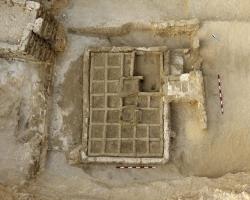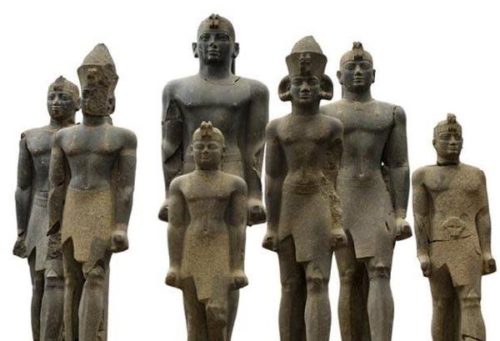As some Pagans and Heathens attempt to revive ancient or indigenous religions they often rely on the work of historians, primary texts and archaeologists. For this reason, when something new pops up that challenges long held academic ideas on cultural or religious practice, we pay attention. Here are some of the new(er) finds making waves in archaeological circles.
Egyptian Funeral Garden Finally Discovered
A 4,000-year-old funerary garden, the first to be found, was uncovered on the Dra Abu el-Naga hill in Luxor, Egypt. Archaeologists had long suspected that funeral gardens existed in Egypt, since there were depictions of them on on tomb walls, but until now, one hadn’t been found.

“Aerial view of the funerary garden discovered by CSIC’s research team. Credit: CSIC Communications”
The garden has a small, rectangular section with 30 raised beds and two trees planted nearby. The plants in the garden are expected to have symbolic and religious meaning and could have played a role in funeral rites. The trees could possibly be palm, sycamore, or Persia trees as those three are associated with resurrection. A small offering bowl containing dates was also found in the garden.
Archaeologists are working with botanists to identify the plants and trees in the garden rough their seeds. The information gathered could be of great use to modern Kemetics as they plan for their funeral rites.
Who gets to claim Hathor?
The goddess Hathor is one of the preeminent deities Egyptian pantheon, but is she Egyptian? New finds are strengthening the case that Hathor was a Semitic deity long before the Egyptians started to worship her.
In addition to more well known aspects of Hathor, such as welcoming devotees to the afterlife, Hathor was worshiped by turquoise miners. The earliest evidence of turquoise mining in the Sinai starts in the 4th millennium BCE and was done by nomadic Semitic peoples.
The main buyer of turquoise was the Egyptians, and around 2600 BCE, the Egyptians took over the turquoise mines, moved operations to to west-central Sinai, and built a shrine to Hathor.
What has archaeologists wondering about Hathor’s origin, and even her name, are the inscriptions found at the shrine. Some of the inscriptions appear to be dedicated to Baalat, a female form of Ba’al, a Semitic God. On other temples, Baalat and Hathor were synonymous and were called Heavenly Matriarch.
The combination of the early inscriptions at the shrine at the turquoise mine, along with the presence of Semitic miners who worked the mine, have Egyptologists theorizing the shrine was built by the miners, who then brought this Goddess into Egypt with them.
Did the Sudan rival Egypt in scope?
The Egyptian Kingdoms have long been thought the zenith of ancient African culture, but could the Kingdom of Sudan been equal or even surpassed it? Swiss archaeologist Charles Bonnet thinks that may be the case after his discovery of three temple in the Sudan.
The round temples date back to 1500 to 2000 BCE and were found near Kerma in Northern Sudan. Round temples in any part of the world are very rare, so the structures stand out for their unique architecture. The temples do not match any known temple structures in Egyptian architecture.

Statuettes from Ancient Sudanese Kingdom [Public Domain photo]
Bonnet believes Sudan’s Nile Valley is the home of several successive large kingdoms that rivaled Egypt.
So you want to be an archaeologist? Now you can!
If archaeology is your passion, but you don’t want to leave the comfort of your home, new technology lets you join in. Space archaeologist Sarah Parcak has created a new online platform that lets anyone with a computer search for new places to dig or to protect those already found.
The program, called GlobalXplorer,. Allows people to flag unusual features that may be an undiscovered structure. To keep people interested and searching, the program is run in a game format. Users can unlock rewards, have access to exclusive YouTube content, and receive other perks.
Parcak’s space archaeology techniques have already helped locate 17 potential pyramids, 3100 potential settlements, and a possible 1000 tombs in Egypt. She hopes, by opening this up to every day people, those numbers can climb still higher.
The Wild Hunt is not responsible for links to external content.
To join a conversation on this post:
Visit our The Wild Hunt subreddit! Point your favorite browser to https://www.reddit.com/r/The_Wild_Hunt_News/, then click “JOIN”. Make sure to click the bell, too, to be notified of new articles posted to our subreddit.
